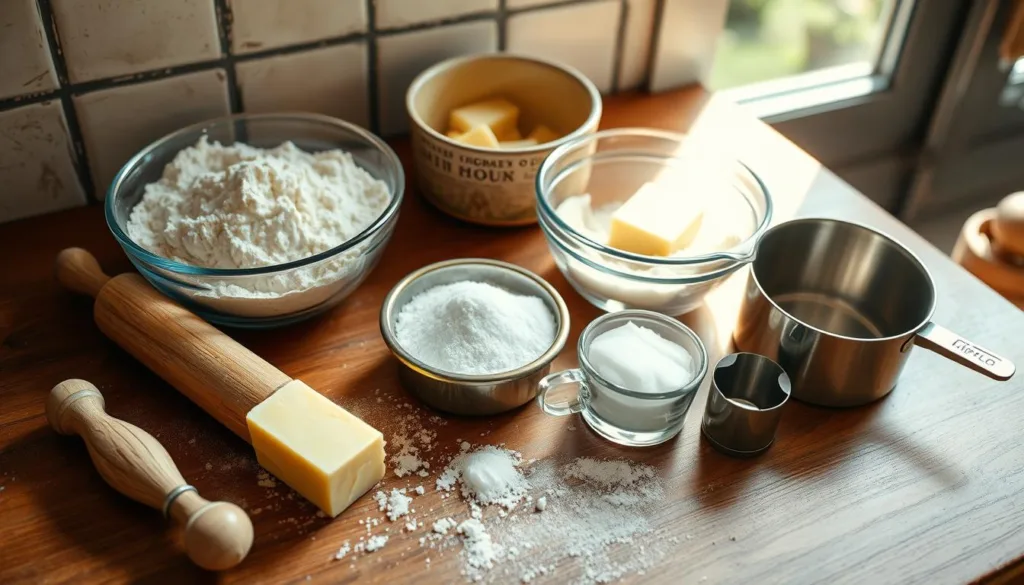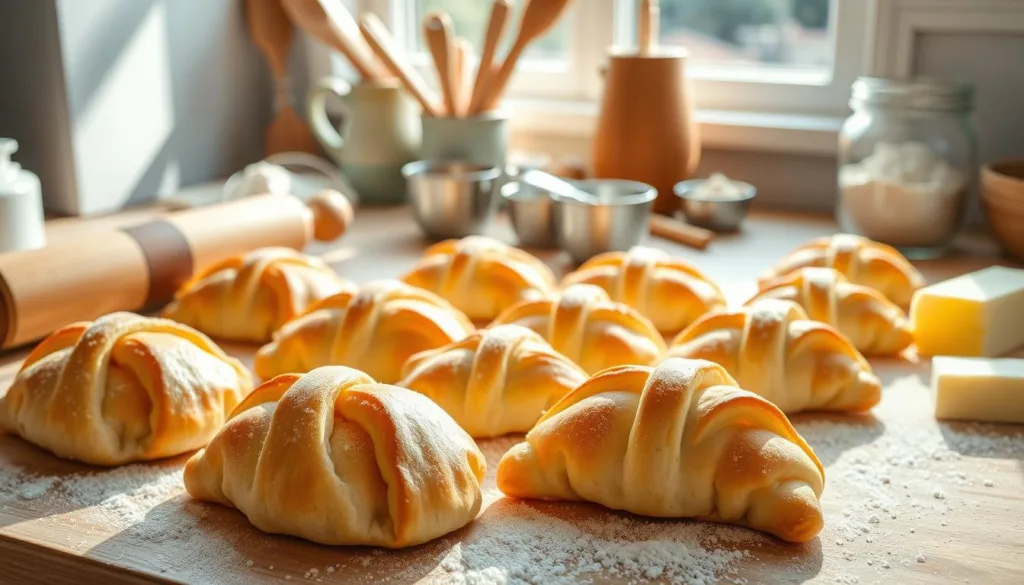
Table of Contents
Wake up to the delicious scent of freshly baked pastries filling the air. Their buttery layers promise a taste of Swiss tradition. My first time making gipfeli changed my breakfast forever. It’s not just baking; it’s connecting to a rich cultural experience in your kitchen.
Gipfeli, the Swiss version of the French croissant, adds a unique twist to pastry-making. Your homemade gipfeli will come together with just seven essential ingredients: flour, sugar, salt, yeast, warm milk, cold butter, and an egg for brushing. With a few simple steps, you’ll make a Breakfast treat that feels like a trip to Switzerland.
This recipe makes the art of making flaky, golden pastries easy. Whether you’re an experienced baker or just starting, you’ll love making Swiss gipfeli. You’ll impress your family and friends with a breakfast that’s both simple and elegant.
Understanding Swiss Gipfeli: The Traditional Croissant Alternative
Exploring Swiss breakfast traditions, you’ll find the traditional Swiss croissant recipe. It’s a pastry with a rich history. Unlike the French croissant, it offers a unique taste for bread enthusiasts.
Origins and Cultural Significance
Gipfeli has delighted the Swiss for more than 200 years, earning its place as a beloved national treat. It started in the early 1800s as a Swiss take on the French croissant. This shows Switzerland’s baking traditions.
- Originated in Switzerland in the early 1800s
- Represents local culinary innovation
- Deeply rooted in Swiss breakfast culture
How Gipfeli Differs from French Croissants
Though they look alike, Swiss gipfeli and French croissants are different. Here’s how:
- Less Buttery: Lighter and less rich than French croissants
- Texture: Crispier outside, softer inside
- Shape: More compact and uniform
Traditional Serving Suggestions
The best gipfeli recipe shines in various ways. You can enjoy it:
- Plain with butter and jam
- Filled with sweet or savory ingredients
- Paired with Swiss coffee or hot chocolate
“Gipfeli is not just a pastry, it’s a slice of Swiss culinary heritage.” – Swiss Baking Traditions
Essential Ingredients and Kitchen Tools for Gipfeli Recipe

To make gipfeli, you need the right ingredients and tools. Start your buttery gipfeli journey by knowing the key ingredients. They turn simple items into tasty Swiss pastries.
Core Ingredients for Perfect Gipfeli
- All-purpose flour (500g)
- Active dry yeast (1 standard packet)
- Lukewarm milk (240ml)
- Sugar (65g)
- Salt (1 teaspoon)
- Eggs (2 large)
- Room temperature butter (113g)
- Cold butter, sliced (340g)
The secret to great gipfeli is the right mix of ingredients. Cold butter is key for flaky layers that make gipfeli so good.
Essential Kitchen Tools
- Large mixing bowls
- Measuring cups and spoons
- Rolling pin
- Baking sheet
- Parchment paper
- Pastry brush
- Plastic wrap
- Damp kitchen cloth
“Precision is the key to perfect gipfeli. Every tool and ingredient plays a crucial role in creating these delightful Swiss pastries.”
For making gipfeli, use quality tools and fresh ingredients. A well-organized kitchen is essential for crafting buttery, melt-in-your-mouth Gipfeli.
Pro Ingredient Tips
- Use unsalted butter for better flavor control
- Ensure milk is lukewarm (around 110°F) for yeast activation
- Measure ingredients precisely for consistent results
- Keep butter cold to create perfect laminated layers
Step-by-Step Gipfeli Preparation Method
Making perfect gipfeli needs care and patience. This guide will show you how to make these Swiss pastries. It’s a mix of old techniques and careful steps.
Dough Preparation Fundamentals
First, get your ingredients ready. You’ll need:
- 500g all-purpose flour
- 250ml warm milk
- 7g active dry yeast
- 50g sugar
- 1 tsp salt
- 250g cold, unsalted butter
- 1 egg for glazing
Mastering the Lamination Technique
The key to real gipfeli is the lamination process. Keep your butter cold and work fast for flaky layers. Roll the dough into a rectangle, add cold butter in the middle, and fold it like an envelope.
Do two to three single folds, chilling the dough for 30 minutes each time. This makes the dough’s layers light and flaky, which is Gipfeli’s charm.
Shaping Your Gipfeli
After chilling, roll the dough to about 3mm thick. Cut into triangles with a 4-inch base and 6-inch height. Roll each triangle from the wide end to the tip, making a crescent shape.
“Precision in shaping is the mark of a true gipfeli master!” – Swiss Baking Tradition
| Stage | Temperature | Time |
|---|---|---|
| Dough Proofing | 75-78°F | 1 hour |
| Baking | 400°F | 15-20 minutes |
Your homemade gipfeli are done when they’re golden brown. Enjoy these tasty pastries fresh, celebrating your skill in making this Swiss treat!
Professional Tips for Perfect Gipfeli Results
Making the best gipfeli recipe needs focus and patience. Getting that perfect buttery texture is all about using expert techniques. These make your home baking feel like a pro’s work.

Temperature control is key when baking your gipfeli. Here are some important tips to remember:
- Keep butter cold, around 40°F, for the best lamination
- Work fast to stop butter from getting too soft
- Chill the dough if the butter gets too soft
- Use a kitchen scale for exact ingredient amounts
“Achieving the perfect Gipfeli comes down to a delicate balance between precise temperature control and careful technique.”
It’s the lamination process that creates those irresistible flaky layers, so roll the dough gently and evenly to preserve each fold.
For authentic Swiss gipfeli, follow these baking tips:
- Preheat oven to 375°F (190°C)
- Bake for 18-22 minutes until golden
- Let pastries cool on a wire rack
Pro bakers suggest mixing bread and all-purpose flour for better structure. During proofing, allow the dough to rise until it doubles in size—this typically takes 1 to 2 hours in a warm, draft-free spot.
Storage tip: Store your gipfeli at room temperature in an airtight container for up to two days. For extended storage, place them in the freezer, where they’ll stay fresh for up to three months.
Conclusion
Your journey to make traditional Swiss gipfeli is more than baking. It’s a dive into Swiss heritage. By mastering this pastry, you connect with Swiss baking traditions for generations.
Making homemade gipfeli might seem hard at first. But with practice, you’ll get better and make these treats with ease.
Traditional Swiss gipfeli is simple yet amazing. You only need flour, butter, yeast, and salt to make it. You can also try different fillings, like almond paste or Nutella, to make each batch special.
Getting good at gipfeli takes patience and skill. The laminating process makes the dough flaky and delicious. Serve them for breakfast, as a snack, or share with friends to show off your baking skills.
This gipfeli recipe is just the start of your Swiss baking adventure. Each batch you make brings you closer to the art of European pastry-making. Enjoy the process, savor the taste, and have fun making Swiss baking a part of your kitchen.
FAQ
What are gipfeli, and how do they differ from croissants?
Gipfeli are Swiss pastries similar to French croissants but with a unique twist. They’re smaller, less buttery, and have a different shape. Gipfeli have a distinct Swiss character that makes them different from French croissants.
What ingredients do I need to make authentic gipfeli?
You’ll need high-protein flour, cold butter, yeast, and milk. Cold butter and the right temperature are key for flaky layers.
Is making gipfeli difficult for home bakers?
Making gipfeli requires skill but is doable for patient bakers. The lamination technique is the most challenging part. With practice, you can master making these delicious pastries.
What’s the total time required to make Gipfeli from start to finish?
It takes about 4-5 hours, including preparation and resting. Most of this time is spent waiting, so don’t worry about the time.
Can I store or freeze gipfeli dough?
Yes! You can refrigerate the dough for up to 24 hours before baking. Freeze the shaped dough for up to 2 weeks. Just thaw and proof before baking.
What are traditional ways to serve gipfeli?
In Switzerland, gipfeli are enjoyed for breakfast with butter, jam, or honey. They’re often paired with coffee or hot chocolate. Some also fill them with ham, cheese, or chocolate for a more substantial meal.
Are there any common mistakes to avoid when making gipfeli?
Avoid using warm butter, overworking the dough, and not keeping ingredients cold. Use cold ingredients, handle the dough gently, and maintain a consistent temperature for the perfect flaky texture.
Can I make gipfeli with alternative flours or dietary restrictions?
You can try using spelt or gluten-free flours, but it may change the texture. Use high-protein wheat flour or look for specialized recipes for dietary needs for the best results.
